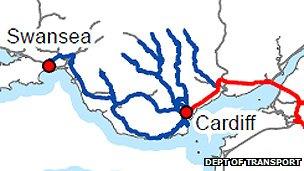Rail electrification to Swansea and south Wales valleys
- Published

The journey from Paddington to Swansea will be cut by 20 minutes
The Great Western rail line is to be electrified between London and Swansea, it has been confirmed.
The Department of Transport said commuter lines in the south Wales valleys would also be electrified.
The UK government agreed last year to electrify the line as far west as Cardiff, and had faced heavy lobbying to extend the investment to Swansea.
One business expert hailed the decision as "the most significant investment in Welsh rail since the Severn Tunnel".

The electrification will now involve the main line to Swansea and the south Wales valley lines
The tunnel was built in the late 19th Century, and completed in the mid-1880s.
Extending the electrification of the main rail line will cut some 20 minutes from the three-hour journey between Paddington and Swansea.
The Department for Transport said once the whole project, including the valleys upgrade, was completed, two-thirds of people in Wales would be served by an electrified train service from their local station.
As well as cutting journey times, the decision to electrify the main line to Swansea means newer, longer trains will be able to run on the line, powered by overhead cables.
Bigger trains
The new trains will have nine carriages instead of the current eight, allowing more passengers to be carried on the line.
Welsh Secretary Cheryl Gillan said the announcement was very good news.
"It shows to people who are thinking about investing in Wales that we are going to have a very modern transport system," said Mrs Gillan.
"So if people are looking to invest in the UK, then Wales and the Valleys and south Wales all the way to Swansea and beyond to the Gower are going to be really open for business."
Mark Barry, a business consultant who wrote the South Wales metro report making the case for improved connectivity to help the economy, said the move would provide a huge foundation for a radical change in Wales' economic performance.
"It's probably the most significant investment in Welsh rail since the Severn tunnel was opened," said Mr Barry.
"What Swansea has achieved today with this announcement is an opportunity... to present itself in a different light.
"Without electrification they would have been perceived as being off the end of the line. Now they are part of the network and that's very important for Swansea."
'Essential'
Geraint Davies MP the Labour MP for Swansea West, said: "In terms of inward investment and business planning the business community wants to know we're on the electric line for the future of the Swansea brand, which is known to 600m people thanks to the football.
"People are basically putting their money down now, or will do, if they know we are part of the wide electrified network."
The main line upgrade to Cardiff, costing more than £1bn, is due to be completed by 2017.
In May a groups of businesses and institutions met in Swansea to press the case for further electrification, including Virgin Media, Virgin Atlantic, Admiral, Amazon, Swansea University and Royal Mail.
Welsh Transport Minister Carl Sargeant had said full electrification of both the valleys and Great Western line through to Swansea was essential.
Electrification of the London-Swansea line was announced by then-Prime Minister Gordon Brown in 2009, but the decision was reviewed by the coalition government after the general election the following year.
Electrification to Cardiff was announced in March last year.
The Department of Transport announcement for south Wales involves overhead electrification of the following lines:
Cardiff Central to Cardiff Queen Street
Cardiff Queen Street to Aberdare
Cardiff Queen Street to Cardiff Bay
Cardiff Queen Street to Coryton
Newport to Ebbw Vale
Cardiff Central to Maesteg via Pontyclun, Bridgend
Abercynon to Merthyr Tydfil
Grangetown to Penarth
Cardiff Central to Danescourt via Radyr (City Line)
Cardiff Queen Street to Rhymney
Pontypridd to Treherbert
Cardiff Central to Bridgend via Barry - Bridgend (Vale of Glamorgan)
Barry to Barry Island
Bridgend to Swansea
The decision comes after a week after the go-ahead was given to a £500m rail link to Heathrow.
From 2021 passengers from south Wales, the west of England and the Thames Valley on the Great Western main line will no longer need to travel to the airport via Paddington.
- Published16 July 2012
- Published16 July 2012
- Published13 July 2012
- Published12 July 2012
- Published23 May 2012
- Published11 May 2012
- Published11 March 2012
- Published24 June 2011
- Published1 March 2011